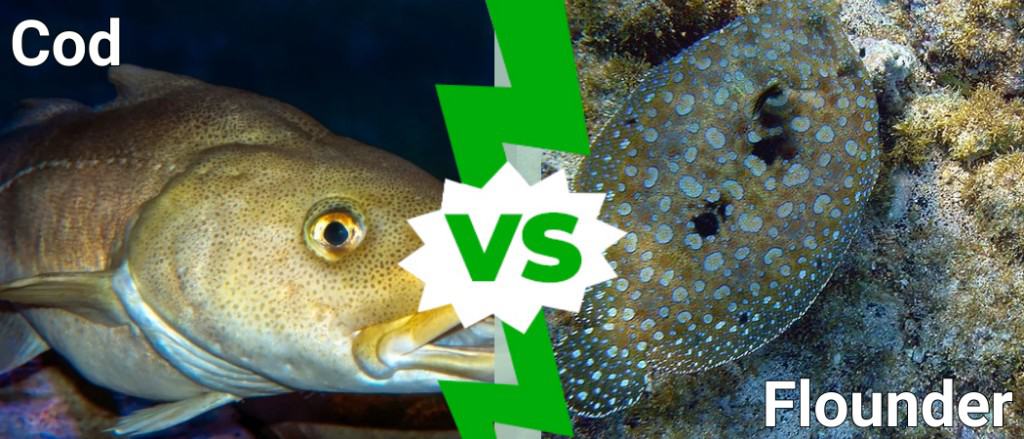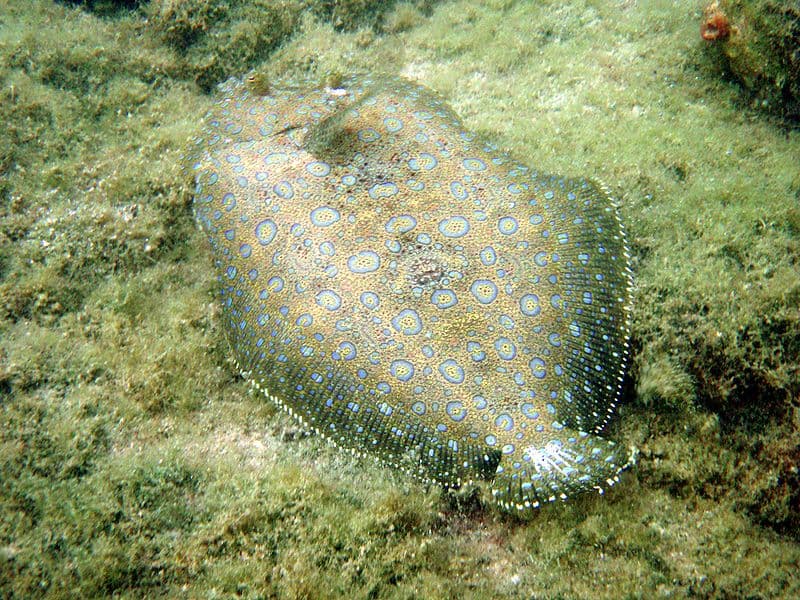There’s an ancient myth behind the constellation of Pisces, which features two fish swimming in opposing directions. When confronted by the god Typhon while walking along the Euphrates River, Aphrodite and Eros were turned into fish by Zeus so they could jump in the water and swim away. If they swam away to the bottom of the ocean, perhaps they were cod or flounder.
As bottom-feeders, cod and flounder are among the ranks of haddock, bass, some species of shark, and catfish. Shellfish, crayfish, crabs, sea anemones, starfish, snails, worms, and sea cucumbers also dwell deep down. As demersal fish, cod and flounder love to hug the ocean floor but they have many features that set them apart. Let’s take a closer look at cod vs flounder and see how they differ.
Comparing a Cod vs a Flounder

| Common Name | Cod | Flounder |
| Scientific Name (Order) | Gadiformes | Pleuronectiformes |
| Size | 60 to 120 cm (24 to 48 in), up to 103 lbs | 22 to 60 cm (8.7 to 23.6 in), up to 22 lbs |
| Traits | Rounded body, three rounded dorsal fins, two anal fins. | Torpedo-shaped body, eyes on one side of head. |
| Hunting | Barbel to find prey | Ambush prey |
| Reproduction site | In water, somewhat above the ocean floor | At the water’s surface |
The 4 Main Differences Between Cod and Flounder
The main differences between cod and flounder are their size, appearance, hunting methods, and reproduction strategy.
We’ll take a look at the way cod and flounder are classified in terms of name and lineage. Then we’ll explore their similar habitats before we get into the 4 main differences between cod and flounder.
Cod vs Flounder: Classification

Cod are
Gadiformes, while flounder are
Pleuronectiformes.
©Vladimir Wrangel/Shutterstock.com
Cod and flounder are both members of the Actinopterygii class. The prefix actino means “to have rays,” and pterygii refers to the Greek word for wings or fins. This is a class of bony, ray-finned fish. Their fins are supported by bony spines in contrast to fleshy, lobed fins.
Cod, also called codfish, are Gadiformes of the Gadidae family. Many species that are no longer classified as part of this genus still retain cod in their common name. Many are members of the Gadidae family, while others are part of other families within the Gadiformes order. To further complicate things, many fish species are marketed as cod that have little relation to true cod species. The main species of the Gadus genus include Alaskan cod (Gadus morhua), Pacific cod (Gadus macrocephalus), and Greenland cod (Gadus ogac).
As flat-bodied fish, “flounder” is the general name for many species that are distantly related. However, they are all part of the order Pleuronectiformes and the Pleuronectoidei suborder. Many of them have both eyes on one side of their head. Some common flounder species include the Gulf flounder (Paralichthys albigutta), Summer flounder (Paralichthys dentatus), Witch flounder (Glyptocephalus cynoglossus), and halibut (Hippoglossus stenolepsis).
Cod vs Flounder: Habitat

Both cod and flounder dwell at the bottom of the sea.
©Gaurav Ruke/Shutterstock.com
Cod are bottom-dwelling creatures living near the seafloor. Atlantic cod live in the deep seas throughout the North Atlantic where waters are cold. Pacific cod prefer the waters of the Pacific Ocean.
Flounder also dwell at the bottom of the seas. Winter flounder are supreme examples of cold-water fish. Others prefer tropical and temperate waters along the coasts of Europe, North America, Africa, and Asia, with some species reaching north into the Arctic.
Cod vs Flounder: Size

On average, cod are larger than flounder.
©Travel Faery/Shutterstock.com
Cod are 24 to 48 inches long and weigh 11 to 26 pounds on average, but they can reach 103 lbs. Pacific cod are typically smaller than Atlantic cod. They have a torpedo-shaped body that is also sometimes pot-bellied in appearance.
Flounder are generally between 8.7 to 23.6 inches in length but can grow up to 37 inches in some cases. They can weigh up to 22 pounds. Flounders have a round body that’s usually approximately half their length giving them a massive surface area. They are flat fish with a body shape well adapted to their bottom-dwelling lifestyle.
Cod vs Flounder: Physical Traits
Codfish are generally brown in color with variations in shades of gray, red, and green. Alaskan cod can actually change color at certain depths from gray-green to reddish-brown. These fish typically have a light underside. They have three rounded dorsal fins, two anal fins, and a pair of pectoral fins. Dark speckles dress their sides and a white lateral line runs from their gill slit to the base of their tails. The lateral line serves the important purpose of detecting motion, vibration, and pressure in the surrounding water. An otolith rests in their skulls, which is a calcium carbonate structure with visible rings that can determine their age.
Many species of flounder are born with one eye on each side of their head but undergo metamorphosis in which one eye moves to the other side. This unique feature allows them to dwell on the ocean floor on one side of their body with both eyes on the top side. These eyes can move independently of one another and give the flounder a good vision of the world above the sea bottom. Against the background of a sandy ocean floor, their scales act as camouflage, making detection by predators difficult. Some species are able to shift color in response to the seabed in further disguise. Their coloring shifts from orange, brown, green, white, and tan and is also dependent on their emotional state, changing in response to threats and other events. Some species have scattered 10 to 14 eye-like markings on their bodies.
Cod vs Flounder: Hunting Strategy and Diet

Flounder blend into the seafloor and ambush prey, while cod seek them out with a special barbel.
The upper jaws of cod extend over the lower, which have a beard-like barbel that serves as a sensory organ for seeking out food. They are active predators that eat a diet of smaller fish like haddock, mackerel, and whiting, as well as worms, mollusks, crustaceans, and sand eels. An article in the CES Journal of Marine Science found that fish make up 59% of the diet of cod on the Faroe Bank. Young cod will eat krill and plankton or small fish as they develop. Northeast Atlantic cod sometimes show cannibalistic behavior, eating members of their own species.
Flounder are primarily nocturnal carnivores who ambush, blending into their surroundings before the sharp snap of teeth surprises their prey. Their diet consists mainly of fish spawn, crustaceans, and small fish. Smaller species take advantage of krill and plankton as food sources. They feed on the ocean floor in muddy areas near bridges, docks, and coral reefs.
Cod vs Flounder: Reproduction
Atlantic cod reproduce through broadcast spawning, in which females release eggs and males release sperm into the water above the seafloor. Cod are social creatures that form schools and group together during reproduction. However, dominant males likely have exclusive access to spawn with available females of the group. They are one of the most productive species of bony fish, with females releasing hundreds of millions of eggs during their lifetimes. This is a reproductive strategy that ensures success despite relatively few of the eggs maturing to adulthood.
The summer flounder, along with many other species, also reproduce outside the body. However, in contrast to cod, they perform this process on the surface of the water. Females release eggs many times throughout the spawning season and can have over four million eggs. Like cod, a relatively small number of fertilized eggs reach maturity with less than three quarters of the eggs surviving to adulthood. After the eggs are fertilized they hatch in just a couple days.
The photo featured at the top of this post is © CT Johnson/Shutterstock.com
Thank you for reading! Have some feedback for us? Contact the AZ Animals editorial team.






